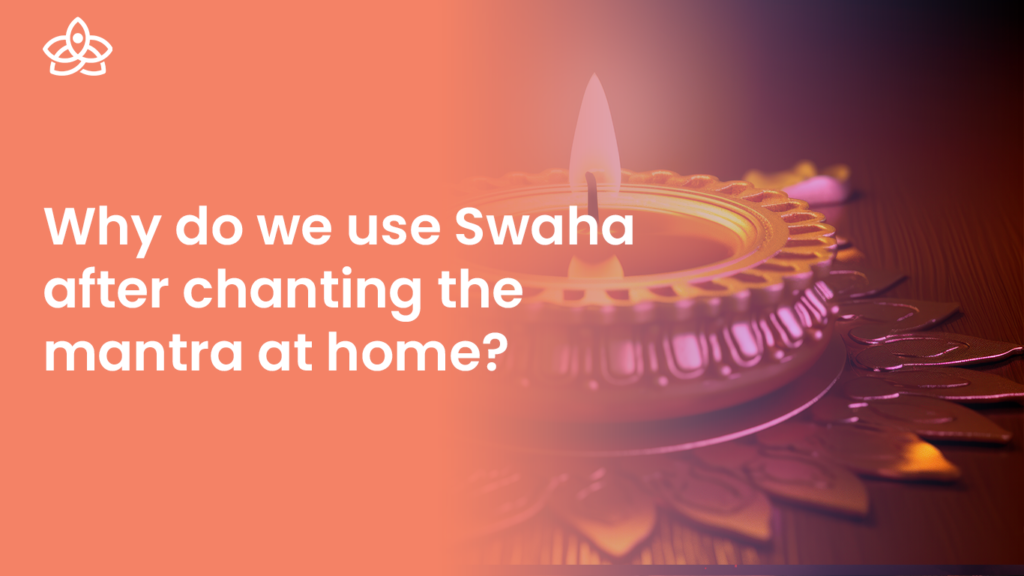Definition of Swaha:
Swaha is a “Sanskrit” word used in Hinduism and Buddhism as the end of a mantra. Swaha is most important in the mantra Yagya. Swaha may indicate several things, but the most simple translation is “well said” or, in Tibetan, “so be it”. The name could be derived from the basic words su, which means “well,”, and ah, which means “to call”.
Havan, or homa, has been traditionally practiced in our country for a long time. In Hinduism, every auspicious occasion has been subject to the Homa or Havan regulation. It is considered that one should remember the god before doing any auspicious work to be effective. The mantra is chanted data; the term Swaha must be said. Then only the sacrifice is carried out.

The main purposes of Swaha in Homa are:
- Swaha is the word generally used in the Yagya, or homa when an offering is made to the fire. Generally, in Yagya, an offering is made to the deity with a deity mantra; in this procedure, after the mantra is chanted, it is followed by the words ‘Swaha’ and ‘Idam-Na-Mama’. The offering is particularly put in the fire with the word ‘Swaha’. The meaning of Swaha through Indian Scripture The description of Swaha is present in all types of Indian literature, i.e., the Vedas, Upanishads, Puranas, Brahmanas, and well-commented scholarly works.
- Swaha is inseparable from Yagya Agni, as she is depicted as the wife of Agni.
- Swaha is an essential portion of the ritual, i.e., Yagya is considered incomplete while offerings are made without chanting Swaha, as Agni cannot avail the offerings to deities.
- Swaha teaches how one should make offerings, i.e., offerings shall be made with complete surrender, humility, and sweetness full of emotions after establishing oneself in wisdom, without ego and attachment, and thus, only such offerings through Swaha can be taken by Agni to the deities for the welfare of the individual and society.
Swaha in the Rig Veda:
Swaha is a feminine term used in the “Rig Veda” to allude to a sacrifice made to the god of fire “Agni”. Some people think Swaha is the name of Agni’s wife and a minor deity who was formerly a nymph. When passive worship is offered at home, a kind of worship done in front of a holy fire, Swaha is chanted. Another justification for its placement at the end of the mantra is that it functions as a kind of fire sacrifice to God in place of the chant itself. The relationship between the Yagya fire and Swaha can also be seen in Shrimad Bhagavata Purana and Shiva Purana. Swaha was the daughter of Daksha Prajapati, who was married to Agni.
The other stories of Swaha:
In Indian culture, the wife is considered half the body of the husband. Hence, the hidden meaning of the story is the strong relationship of ‘Swaha’ during oblation in the Yagya Fire. In Yagya, Agnidev is also known as the carrier of all offerings to the deity. It is also an interesting fact that Agnidev accepts offerings only through his wife ‘Swaha’, and through Agnidev, the same offerings are received by the invoked deity.
Apart from this, unique fiction about the origin of Swaha exists. Swaha was a natural artist whose marriage to Agni was done at God’s request. Swaha received this blessing from Lord Shri Krishna himself, who promised that the deities could only accept sacrifice through him. It was evident that the word “Swaha” plays a significant role in Yagya and in determining when offerings must be made in the Yagya fire.
Namah and Swaha are the same in the mantras:
“Mantra” is a collection of words that energize our minds and shield us from all forms of fear.
‘Man’ is a mental focus. The word ‘Tra’ implies relief. The words carry energy and reproduce when they are said more frequently.
Namah, which can be used to worship both God and goddesses, means “I offer.” It is not gender-specific. Chanting ‘Namah’ after the phrase sends energy throughout our organic being and is very beneficial for preserving abundance for healing and also for appeasing any deity.
A mantra that ends in “swaha” is chanted as oblations are presented in the fire. “Swaha” is a term used after mantras to provide additional vitality to them. ‘Swaha’ is used simultaneously when we chant to banish certain diseases or negativity.
Conclusion:
The description of Swaha is present in all types of Indian literature, i.e., the Vedas, Upanishads, Puranas, Brahmanas, and well-commented scholarly works. It is present throughout scriptural history. In addition, the indication of the utility of Swaha in Tantric and Vedic spiritual practices attracts the potential of future studies. The implications of Swaha, i.e., Swaha, are inseparable from Yagya Agni, as she is depicted as the wife of Agni. Swaha is an essential portion of the ritual, i.e., Yagya is considered incomplete while offerings are made without chanting Swaha, as Agi cannot avail the offerings to deities.
Swaha teaches how one should make offerings, i.e., offerings shall be made with complete surrender, humility, and sweetness full of emotions, after establishing oneself in wisdom, without ego, and attachment, and thus, only such offerings through Swaha can be taken by Agni to the deities for the welfare of society.



